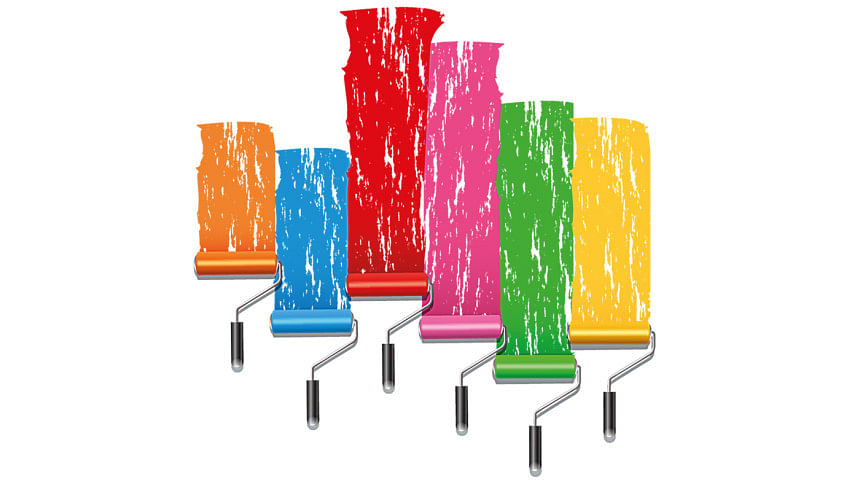More than colour how to choose paint that fits your life

In Dhaka's ever-expanding skyline, where apartments compete for light, heat, and breath, paint is not just the final touch – it's the invisible layer that makes a house livable. However, we don't talk about it enough. We obsess over floor tiles and kitchen backsplashes but settle for "off-white" on every wall. Yet paint touches everything. It colours our moods. It shapes our air. It either soothes us or suffocates us.
The mistake most people make is thinking paint is just colour. It's not. As Gazi Md. Saiful Alam, Brand Executive at Dulux Paints Bangladesh, puts it, "Paint today is more than just colour; in reality, it's chemistry. The kind you choose isn't just about the finish. It's about fit."
Hence, understanding the role of paint, room by room, can make all the difference in creating a home that's not just stylish but healthy, functional, and expressive.
When colour has to care
Children's bedrooms are often painted with pastel optimism, chosen more for aesthetics than function. Yet this is the one room where paint does more than beautify – it protects.
Alam advises parents to opt for water-based acrylic emulsions, which are breathable, low in odour, and safe for sensitive users. "They're often preferred in bedrooms, living rooms, and children's spaces where comfort and safety matter most," he says.
Soft greens, light blues, and dusty pinks offer a comforting palette while calming the nervous system. Nadia Rahman, who frequently designs nurseries and kid-friendly spaces, notes, "Comfort has a colour language. And it can be both soothing and imaginative when used intentionally."
Rajesh Sircar, General Manager of Nippon Paint Bangladesh, adds that modern concerns have shifted toward wellbeing. "Our Spotless Plus range includes antiviral and antibacterial properties that address the need for healthier indoor air quality, especially in spaces used by children," he explains.
The teenage room: Where mood meets paint
Teenagers often want black walls and dramatic colours. While many parents hesitate, design experts say it's about finding a balance and controlled expression.
Dark greens, deep blues, and clay-inspired earth tones often strike the right balance between personality and longevity. Alam advises testing such tones under natural daylight, as Bangladesh's overcast monsoon light can dramatically alter how paint appears indoors.
Shayaan Seraj, Director of Aqua Paints, notes that their InstaColor system and AI-based shade recommendations help teenagers and homeowners alike visualise colours in their actual environment. "We're empowering homeowners with tools that make colour personal. Whether it's a soft grey for sophistication or a rich maroon for drama, the idea is to help people connect with their space," he says.

The bedroom: A private retreat
Bedrooms demand rest, and paint choices should encourage that. Cool tones like powder blue, lavender, or warm grey promote calm. Matte or eggshell finishes create a soft, tactile quality that feels restful at the end of the day.
Rahman advises clients to avoid glossy finishes here. "Bedrooms should feel like retreats. You don't want your walls bouncing light and energy when you're trying to wind down."
For those sensitive to odours or allergens, low-VOC or VOC-free paints are a must. "A freshly painted room should feel like a fresh start – not a health risk," Alam warns.
Paint that does more
In a tropical country like Bangladesh, paint must perform under stress. High UV, heavy monsoons, and urban pollution put walls under pressure year-round.
Seraj says Aqua Paints is focusing on "elastomeric roof compounds that reflect heat and resist monsoons," while Sircar highlights WB Solareflect, a heat-reducing exterior paint by Nippon that helps reduce energy use by minimising heat absorption.
Alam adds that premium paints are built for endurance. "They contain finer pigments, stronger binders, and additives that turn a painted surface into a performance surface. The cheapest paint often becomes the most expensive over time once you factor in repainting and maintenance."
Avoiding common paint mistakes
Experts agree that poor application ruins good paint. Skipping primers, ignoring surface preparation, testing shades under artificial light, or choosing colours based on memory are common errors.
Rahman stresses that supervision is crucial. "If your painter is choosing the paint and mixing colours from memory, you've already lost control of your project."
Alam adds, "Without proper oversight, shortcuts become standard practice—and they'll show up on your walls soon enough."
What a wall says about a home
Every wall in your home tells a story – not just to guests, but to the people who live there every day. Children touch it. Teens lean against it. We hang memories on it. And when we get it wrong, we feel it – even if we can't name the discomfort.
The smartest homes don't follow colour trends. They follow context. They consider light, air, function, and feeling. And once you begin to see paint not as decoration but as a living part of your space, you'll approach it with the respect and curiosity it deserves.
As Alam says, "Paint isn't just how your home looks – it's how it breathes, protects, and nurtures your family through every season. In Bangladesh's demanding climate, that's a decision worth mastering."

 For all latest news, follow The Daily Star's Google News channel.
For all latest news, follow The Daily Star's Google News channel. 



Comments